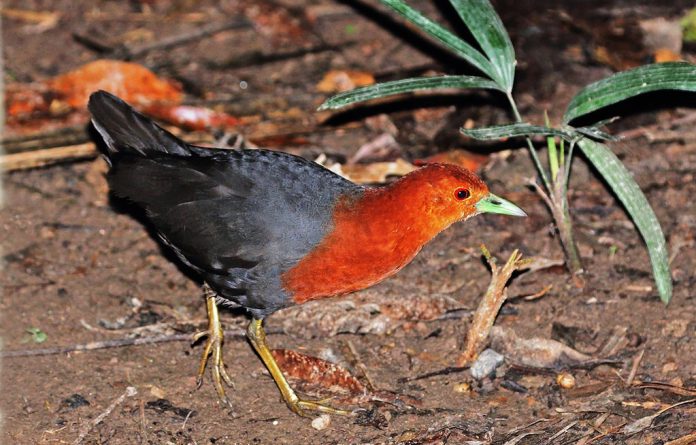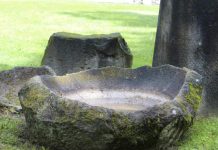The Red-necked crake (Rallina tricolor) is Australia’s only rainforest-inhabiting rail. This crake is found only in coastal northeastern Queensland. It lives on the forest floor within the cover of rainforest and vine scrub, habitually in damp pockets along streams.
The bird rests and sleeps through much of the day, probably on roosting platforms in rock crevices, the crowns of palms, and in tree buttresses. At dusk, it comes out to feed, remaining active well into the night. Red-necked crake strutting along upright, its blunt tail erect and flicking, it works methodically along shallow stream beds and adjacent banks, raking over pebbles and leaf litter with bill and feet, and probing for frogs, tadpoles, and crustaceans in water or insects, amphipods, snails and worms on land.
Seeds of plants are also taken but less often. Searching for food, the birds occasionally venture along tidal channels. When disturbed, they are quick to take cover under roots and banks, darting off with heads hunched and wings partly spread.
They cross creeks readily by swimming, both above and below the surface. Flight is floppy and noisy but the crakes can fly silently, as nightjars do. Much of the Australian population is sedentary, particularly those who live in established-prime territory in the Cooktown-Ingham area of northeastern Queensland. The northern Cape York Peninsula, however, seems to be more fluid. Many birds, including probably the young of the year, appear to disperse to southern New Guinea and fringing islands each winter.
In northeastern Queensland, adult pairs of Red-necked Crakes seem to hold territory year-round. Nesting is heralded by mutual dueling choruses from dusk until late into the night. The nest may be a leaf-lined scrape on the ground at the base of a tree or, more usually, a saucer of dry leaves in a plant or fork of a tree, on the sloping ground near water.
The female lays on consecutive nights until the clutch is complete, and only then sits to incubate. This ensures that the eggs hatch together. She carries out the bulk of brooding, at least during the day, but her mate may do so at night. At this time, the birds are bolder towards intruders and, if disturbed, may squat, fluff their feathers, and flutter in a shivering manner. This is to distract the intruder from the nest.
The chicks, open-eyed and strong in the leg at hatching, are soon out and about, although they still return to the nest to sleep for the first few days. They begin to feed themselves in three to five days and are assisted by their parents for another week or two. Normal feathering replaces them in four-six weeks. The bird is also known as “Scrub Rail”. A Red-necked crake is about 267-290 mm in length; however, the adults are of similar sexes.
The head, neck, breast, and upper shoulders are bright red-chestnut; the throat is paler. The back and wings are plain dusky and olive-brown. However, the belly, flanks, and undertail were coverts with dusky brown, each feather tipped with a narrow buff-white band. Wing feathers on the underside are spotted and barred with an irregular white pattern. It has red eyes, a grayish yellow-green bill, and olive-colored feet. The immature bird’s upperparts are uniformly mid-brown-gray; underparts paler mid-gray-brown, whiter on the throat. Flight feathers are dark brown barred white.
The downy young are plain black; eyes are brown with black bills, and feet are flesh-gray. The call of Red-necked crake is loudly frequent, harsh naak, nak-naknak, with emphasis on the first syllable, then in a descending pattern, which may go on for a minute or more, in which case calls remain on the same note. The bird is often given in a chorus by territorial pairs at dusk. Also, its call is like tock, tock, tock, or plop-plop-plop, which may go on for hours; contact noises like piglets grunting. Abrupt cluck when disturbed.
The nesting and breeding season is November-April. The birds build a nest of a few leaves between the buttresses of a tree or a more substantial cup-shaped structure up to 2 meters above ground in the heart of a small pandanus palm or bird-nest fern.
Normally the birds lay three to seven, usually five; glossy white eggs, soon becoming discolored; rounded-oval, about 30 x 29 mm. The incubation period is about 19-22 days, mainly for females. The distribution of Red-necked crake is restricted to rainforests on the Eastern Cape York Peninsula, south to Ingham on the Herbert River. Also found in New Guinea, close by islands, the outer Bismarck Archipelago, and islands in the Banda Sea. Four races; in Australia: one nomadic in the northern Cape York Peninsula; the other larger and sedentary from Ingham to Cooktown.
Read More – American Purple Gallinule (Porphyrio martinicus)









